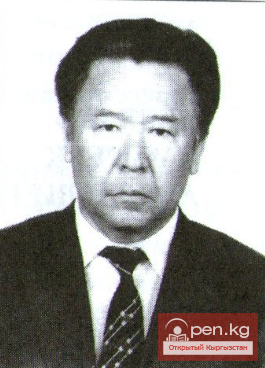The term "shirdamal" is used among the pre-Fergana Kyrgyz. Carpets by this name are made here only by Kyrgyz who identify themselves with the tribal groups of Adigine, Mongoldor, and Mungush. Northern Kyrgyz refer to such a carpet as "shyrdak." Among the Kazakhs, a similar carpet is called "syrmak," "syrdak," or "syrdamal." In the past, it was laid on the ground in a yurt, used during migrations, covering the loaded camel. Nowadays, it serves as a beautiful decoration in the home.
Its shape is the same as that of a carpet with a rolled pattern, with approximately the same aspect ratio: 1.5x3 m. In terms of durability, "shirdamal" surpasses "ala kiyiz." With careful use, it can last up to forty years. The production of such a carpet is significantly more complex than that of a carpet with a rolled pattern; the processing of the felt is somewhat different: it is rolled after washing, drying, and beating the wool, and the rolling process requires a longer time, as the felt must be very dense and thin (up to 0.3-0.5 cm).
The felt made from wool is subject to dyeing. It is usually dyed in three colors: red, blue, yellow, or orange (green has recently been introduced). Natural-colored wool—white and brown—is also used. These colors are combined in specific combinations: red and blue, white and brown; less commonly, brown and orange are combined in carpets, but the latter often appears as a third color in red-blue designs.
The technique of ornamenting felt with mosaics is described in literature about the Kyrgyz and Kazakhs. The same techniques are used by southern Kyrgyz.
The construction of the ornament in the "shirdamal" carpet is based on the combination of two contrasting colors. The patterns are cut simultaneously from two identical pieces of felt of different colors. The cut patterns are laid out, and the edges of the felt of different colors are sewn together. This method creates the upper side of the carpet, under which simple felt or some handwoven material is placed and carefully quilted with wool thread called "shoona." The lines of stitching are arranged parallel to the contour of the ornament. Quilting not only gives strength to the pattern but also a unique relief.
The final stage of work is the masking of the seams of the cut patterns by sewing on a cord (jeyek), which is made from wool (pink, orange, red, white) in various ways: using the "syzma" technique and by twisting two wool threads of different colors (ala jeyek — variegated cord).
Creating the ornament requires significant experience in cutting patterns. This is done by craftswomen (oymotsu). Carpet makers are the keepers of the ancient national traditions in ornamental art. However, while carefully preserving traditions, the craftswomen introduce much of their own originality, being true creators. They create new forms and compositions of patterned felt carpets, enriching Kyrgyz ornamentation. In most cases, craftswomen do not make or keep any stencils. They cut the felt with a sharply sharpened knife or scissors along a previously chalked outline of the pattern, skillfully coordinating not only the construction of the ornament in the carpet, its composition, but also the size, dimensions, and shape of the carpet or other product.
A woman who can both cut patterns and sew carpets is particularly respected in the community. Such a craftswoman is always ensured orders. There are no established norms for payment for work. Previously, the labor of a craftswoman was rewarded with goods, such as lambs or grain. Recently, customers have started to pay craftswomen with money.
Felt carpets have traditionally been part of the dowry among the Kyrgyz. Wealthy families used to invite the best craftswomen to the bride's home, where they participated in preparing the dowry.
Memories of the great creative labor are well preserved in the minds of the older craftswomen. For example, Jamal Shaneva (village Tokbay-Tal of the Soviet district), who is now about eighty years old, has spent more than fifty years cutting patterns for carpets and other felt products not only from felt but also from woven materials—for appliqués. Jamal was also known as an excellent craftswoman of felt carpets. She created various patterns by quilting monochromatic felt. She dyed the felt in red and yellow colors herself.
It is characteristic that in the 19th century, southern Kyrgyz did not produce "shirdamals" for sale. They were only brought to the market in cases of extreme need in the family.
The artistic merits of felt carpets largely depend on the quality of the felt (smoothness, thinness), the elegance (thinness of processing and color) of the cord that masks the seam of the multicolored felt cutouts, as well as the quilting. The decisive factor in evaluating the artistic side of the carpet is the dyeing of the felt, which determines the vibrancy and richness of the contrasting color combinations.

S. M. Dudin notes that a feature of the composition of Central Asian carpet products is the balance between the background and the ornament, which occupy approximately the same area. This striving for rhythmic balance is also noted in felt carpets (with rare exceptions). This is largely determined by the technique of creating felt mosaic products, where identical in shape but different in color backgrounds and patterns are duplicated. Therefore, a characteristic feature of felt mosaics is the repetition of ornamental motifs, which, however, do not create an impression of monotony.
The patterns are characterized by smoothness and roundness of forms, which is also typical for similar felt products from deep antiquity. Felt products found in the Pazyryk barrows vividly confirm this. The principles of their production are analogous.
Craftswomen impart to the ornament in "shirdamal" carpets and other mosaic products essentially the same meaning as the ornament in "ala kiyiz" carpets. The main motif is the curl, which can be represented in many combinations and is considered as a ram's horn — "kochkor muiyuz."
In a felt carpet, there is necessarily an ornamented border with an average width of 25-30 cm. It is decorated with uniform patterns, sometimes constructed on the principle of positive and negative. The pattern of the border is diverse, but the motifs of smoothly rounded contours are always rhythmically repeated in it. The most common are "kyial," "kochkorok," "karga tyrmak," "sytsar muiyuz," and "kush" — a predatory bird.
The same motifs are used in the central field of "shirdamal" and other mosaic products. They are only diversified by various combinations. In general, there are many variations in the decoration of the central field of the carpet. This especially manifests the creative initiative of the craftswomen. We will note the most characteristic ones.
Quilting of felt is considered ancient. More often, it is quilted by placing the pattern along the long axis of the carpet in three to four rows. Quilting gives great strength. The border of the carpet in such a design of the central field is always ornamented with a cut pattern.
In ancient Kyrgyz felt products, various patterns were created in this way. S. M. Dudin describes several methods of quilting felt products: in a spiral (which remains the most common in southern Kyrgyzstan to this day), in concentric circles, zigzags, parallel lines, and meander stitching.
The quilting of felt products has been excellently mastered by the Mongols, who have achieved great artistry in this. The second option for decorating the central field is filling it with a repeating pattern of one outline. The background has the same pattern and arrangement, making it difficult to determine where the background ends and the pattern begins. The most popular pattern made in this way is called "salbay." This pattern has penetrated into the southeastern regions of the Osh region, where it is found not only in mosaic technique but also on mats made from chiy and pile carpets.
Craftswomen associate the name of this pattern with the name of a connoisseur of Kyrgyz ornamentation and a prominent master, Salbay from Tian Shan. An analogous method of ornamentation was known in antiquity. It has been discovered on artifacts from excavations in Northern Mongolia.
The third variant can be attributed to carpets with an archaic design, which likely features one or two monochromatic patterns in the central field, often lacking symmetry. The background stands out sharply. Kyrgyz craftswomen consider this ornament to be the most ancient. We have encountered carpets with similar designs among the Kyrgyz of the Pre-Issyk-Kul and Talas Valley.
The fourth variant includes carpets where the patterns are arranged in one or two rows along the long axis of the central field.
This variant can also include carpets whose central field is occupied by cross-shaped medallions arranged in one or, less commonly, two rows.
The fifth variant consists of carpets whose central field is filled with diagonally placed rhombuses filled with patterns. The triangular spaces formed between the rhombuses are filled with the same motifs. Sometimes the color of the background and the pattern alternates in such a composition. The edge of the central field is often trimmed with a strip cut from white, yellow, or orange felt in the form of jagged or triangular protrusions (the pattern is called "barmak" — finger).
A variation of such a composition can be considered carpets whose central field consists of squares filled with a uniform pattern.
In both the technique of production and the artistic aspect, the southern Kyrgyz "shirdamal" is essentially not different from the northern Kyrgyz carpet "shyrdak," except that in Issyk-Kul, Tian Shan, and the Talas Valley, the art of making "shyrdak" has developed significantly more.
Among other ornamented felt products that were common in the past in southern Kyrgyzstan, the most commonly used were strips called "sdzhabyk bash." Their coloring predominantly featured blue and red colors. The pattern is essentially the same as that on the border of a mosaic felt carpet. Sometimes the pattern was placed in two parallel rows. The bottom of the entire strip was bordered with fringe.
Ornamented felt bags (as well as bags sewn from velvet and red cloth) were made in various shapes: square, rectangular, round, oval; they were also made in the form of an envelope with a triangular flap (for square bags) and with a semicircular flap (for round or oval bags). Bags were also made without flaps. The edges were trimmed with fringe woven from wool, less often from silk. Usually, one large pattern (mainly with the "kochkorok" motif) was placed on the bag. Two bags were made at once, so the color of the pattern and background on them were opposite.
















































